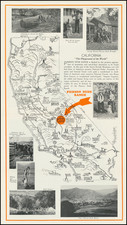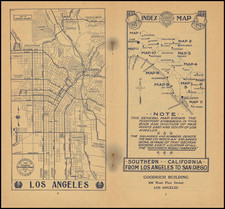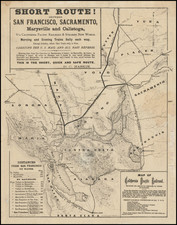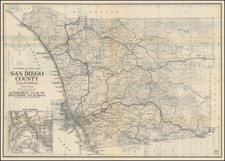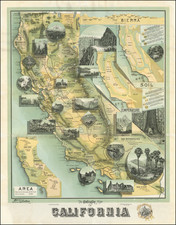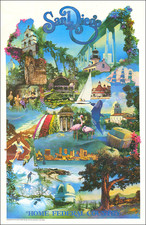Fine Early Birdseye View of San Diego
Extremely rare two-stone tinted-lithograph view of San Diego, made by California's greatest view maker, Eli Sheldon Glover, in 1876. The view was published by Schneider and Kueppers of San Diego and lithographed by A.L. Bancroft & Company of San Francisco.
The note in the lower-left corner reads: "Showing the central portion of the city, with the actual improvements; San Diego Bay and Peninsula, the Entrance to the Harbor, Point Loma and the Los Coronados Islands, twenty miles distant in the Pacific Ocean." The note in the lower-right corner reads: "The County Seat of San Diego County and the proposed Terminus of the Texas Pacific Railroad. Present population, about 4,000. A thriving commercial town; publishes two newspapers, the "San Diego Union" and "World," weekly and daily editions."
E.S. Glover, received favorable comment in the San Diego Union for May of 1876 as a “talented artist” who “has taken a very fine sketch of San Diego.” Looking southwest across the bay, Glover depicted the city in minute detail showing even such small structures as sheds and windmills. In the distance the peninsula of Coronado lies almost vacant of buildings, while farther out the Point Loma Lighthouse stands watch at the harbor entrance.
This is one of the earliest bird’s-eye views of San Diego. Reps notes two earlier views, known in a single copy, one by Higgins and one by George Baker.
There are at least two states of Glover's view.
- State 1: Erroneous imprint: “Drawn by E.S. Clover [sic] and Published by Schneider and & [sic] Kueppers, San Diego.”
- State 2: Imprint corrected. Cowboy on horseback trying to lasso three cows in foreground at lower right added.
Rarity
Reps locates examples at the Amon Carter Museum of Western Art; Library of Congress; University of California, Berkeley; and Chicago Historical Society.
All versions of the view are extremely rare on the market.
Appendix: Key
The view includes the following 24 listed landmarks:
- Presbyterian Church.
- Baptist Church.
- Methodist Church.
- Episcopal Church.
- Catholic Church.
- Public Schools.
- Point Loma Seminary.
- San Diego Academy.
- Bank of San Diego.
- Commercial Bank.
- City Hall.
- Central Market Building.
- Horton's Hall.
- Telegraph Offices.
- Horton House.
- San Diego County Court House.
- Lyon House.
- Bay View Hotel,
- Government Barracks.
- San Diego Flouring Mill.
- San Diego Farming Association.
- San Diego Foundry.
- San Diego Planning Mill.
- City Brewery.
Eli Sheldon Glover (1844-1920) was one of the great viewmakers of the golden age of American bird's eye views. He began his career working for Albert Ruger in Ypsilanti, Michigan in 1866. He was primarily a sales agent for Ruger but probably also helped him in the actual production of city views. Two years later Glover went to Chicago to become a printer and publisher under his own name, but his Merchants Lithographing Company was shortlived; it was destroyed by the 1871 Chicago Fire after only three years of operation. The Great Fire caused Glover to look farther afield, and he began making views in Ontario and Kansas. Slowly he made his way west, producing Colorado views in 1873-'74. In 1874, while based in Salt Lake City he traveled the Rocky Mountains and produced views in Montana, Utah, and Wyoming. In 1876 and '77, the Glovers lived in Los Angeles and Eli produced a total of 16 views of California cities. In the last period of his active career, he focused on views in Oregon, Washington, and British Columbia. His second to last view was in Alabama, and his final view, in 1912 after a long hiatus, was Port Arthur, Texas.









